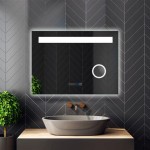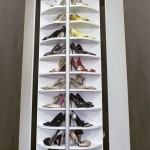How to Hang a Bathroom Framed Mirror: A Comprehensive Guide
Hanging a framed mirror in a bathroom can significantly enhance the space's aesthetics and functionality. A well-placed mirror can visually expand the room, reflect light, and provide a practical surface for grooming. However, improper installation can lead to damage to the mirror, the wall, or even personal injury. This article provides a detailed guide on how to hang a bathroom framed mirror safely and effectively.
Before commencing the installation process, careful planning and preparation are paramount. This includes selecting the appropriate mirror, gathering necessary tools and materials, and accurately measuring and marking the desired location. Taking these preliminary steps will minimize errors and ensure a professional-looking result.
Key Point 1: Preparation and Material Gathering
The first crucial step involves preparing the bathroom and gathering the necessary materials. This involves selecting the right type of mirror mounting hardware based on the mirror's weight and the wall's composition.
Mirror Selection: Choose a mirror that complements the bathroom's overall design and size. Consider the frame style, size, and weight of the mirror. A heavier mirror will require more robust mounting hardware. It's advisable to weigh the mirror before purchasing mounting hardware to ensure its weight capacity is sufficient.
Tool and Material Collection: The following tools and materials are typically required for hanging a framed bathroom mirror:
*Measuring Tape: For accurate measurements of the wall and mirror.
*Level: To ensure the mirror is hung straight.
*Pencil: For marking the wall.
*Stud Finder: To locate wall studs for secure mounting (highly recommended for heavier mirrors).
*Drill: For creating pilot holes and installing anchors.
*Drill Bits: Select drill bits appropriate for the wall material (e.g., drywall, tile, plaster).
*Screwdriver: To tighten screws for mounting hardware.
*Wall Anchors: If studs are not available, use appropriate wall anchors that are rated for the mirror's weight. Common types include plastic anchors, self-drilling anchors, and toggle bolts. Choose anchors based on the wall material and the manufacturer's weight recommendations.
*Mounting Hardware: This will vary depending on the mirror's design. Common options include D-rings, wire hangers, or pre-installed brackets. Ensure the hardware is compatible with the chosen wall anchors or screws.
*Safety Glasses: To protect eyes from debris during drilling.
*Gloves: To protect hands and provide a better grip.
*Painter's Tape: To protect the wall surface around the drill holes and keep the mirror in place while marking holes.
Wall Assessment: Determine the type of wall you will be drilling into (drywall, plaster, tile). Drywall is the most common, but tile requires specialized drill bits and techniques to avoid cracking.
Safety Precautions: Always wear safety glasses when drilling. If drilling into tile, use a slow speed and apply constant, even pressure to avoid shattering the tile. Be aware of the location of pipes and electrical wiring behind the wall when drilling.
Key Point 2: Accurate Measurement and Marking
Precise measurement and marking are crucial for ensuring the mirror is hung level and at the desired height. Taking extra time during this step can prevent costly mistakes and ensure a professional finish.
Determining the Desired Height: The ideal height for a bathroom mirror typically positions the center of the mirror at eye level for the average user. This may need to be adjusted based on the height of the individuals who will be using the mirror most frequently. Consider the height of the vanity and other bathroom fixtures when determining the mirror's placement. Generally, the bottom of the mirror should be several inches above the top of the faucet or backsplash.
Measuring and Marking the Wall: Once the desired height is determined, use a measuring tape to mark the position of the top edge of the mirror on the wall. Use a level to ensure the mark is perfectly horizontal.
Locating Studs (Optional but Recommended): Use a stud finder to locate wall studs. If a stud is located where the mounting hardware will be placed, you can securely attach the mirror directly to the stud using screws, without the need for wall anchors. This is the most secure method for hanging a heavy mirror.
Marking Mounting Hole Locations: If using D-rings or wire hangers, measure the distance between the mounting points on the back of the mirror. Transfer these measurements to the wall, ensuring the marks are level and centered. Use painter's tape to mark the drilling locations to prevent the drill bit from slipping and damaging the wall surface.
Double-Checking Measurements: Before drilling any holes, double-check all measurements and markings. It's always better to take the time to verify the accuracy of the measurements than to have to repair incorrectly placed holes later.
Key Point 3: Installation and Securing the Mirror
With the preparations complete, the final step involves drilling the pilot holes, installing the wall anchors (if needed), and securely hanging the mirror. This requires careful attention to detail and adherence to safety guidelines.
Drilling Pilot Holes: Using the marked locations, drill pilot holes into the wall. The size of the pilot hole should be slightly smaller than the diameter of the screws or wall anchors. If drilling into tile, use a specialized tile drill bit and apply slow, even pressure to avoid cracking the tile. Start with a smaller pilot hole and gradually increase the size as needed.
Installing Wall Anchors (if necessary): If studs are not available, install wall anchors into the pilot holes. Follow the manufacturer's instructions for the specific type of anchor being used. Ensure the anchors are flush with the wall surface. For drywall, self-drilling anchors can be screwed directly into the wall without pre-drilling. For heavier mirrors, toggle bolts provide the strongest hold, but require a larger hole and more careful installation.
Attaching Mounting Hardware: Once the anchors are in place (or if attaching directly to a stud), attach the mounting hardware (e.g., screws) to the wall. Leave a small gap between the screw head and the wall to allow the mirror's D-rings or wire hanger to be easily attached. Choose screws that are long enough to penetrate the stud or anchor securely, but not so long that they will protrude through the wall.
Hanging the Mirror: Carefully lift the mirror and align the D-rings or wire hanger with the screws on the wall. Gently lower the mirror onto the screws. Ensure the mirror is securely supported before releasing it.
Verifying Level and Stability: Use a level to ensure the mirror is perfectly level. If necessary, make small adjustments to the screws to correct any unevenness. Gently push on the mirror to ensure it is securely attached to the wall and does not wobble. For added security, consider using adhesive pads on the back of the mirror to prevent it from shifting.
Final Touches: Once the mirror is securely hung, clean any smudges or fingerprints from the glass and frame. Inspect the installation for any loose screws or gaps. If necessary, apply caulk around the edges of the mirror to seal it to the wall and prevent moisture from seeping behind it. This is especially important in bathrooms with high humidity.
By following these detailed instructions, individuals can confidently and safely hang a framed mirror in their bathroom, enhancing both its aesthetic appeal and functionality. Remember to prioritize safety and take the time to ensure accurate measurements and secure mounting.
Consistent with best practices, the mounting hardware should always be able to support more than the weight of the mirror. It's recommended to choose hardware that can handle at least 1.5 to 2 times the mirror's weight for an extra margin of safety.
In cases where the wall is damaged or requires significant repairs, it is recommended to consult with a professional contractor to ensure the wall is structurally sound before hanging a heavy mirror. This can prevent future problems such as the mirror falling or causing damage to the wall.
If the mirror is particularly large or heavy, consider enlisting the help of a second person to assist with lifting and positioning the mirror during installation. This can prevent accidents and make the process easier and safer.

How To Install A Mirror Without Frame Merrypad
How To Hang Bathroom Mirrors Frameless Framed With Hooks

Guide To Hanging Bathroom Vanity Lighting And Mirrors Liven Design

Tutorial How To Hang A Bathroom Mirror The Diy Playbook

How To Frame A Mirror

How To Hang A Mirror On Tile Wall Remington Avenue

How To Hang A Heavy Mirror Diy Family Handyman

How To Hang Mirrors On Tile 3 Ways A Bonus The Palette Muse

How To Hang Mirrors On Tile 3 Ways A Bonus The Palette Muse

Angeles Home 32 In W X 33 H Rectangular Framed Wall Mounted Waterproof Solid Wood Bathroom Vanity Mirror Navy Blue Easy Hang Mr32ys1nb 8ck The Depot








